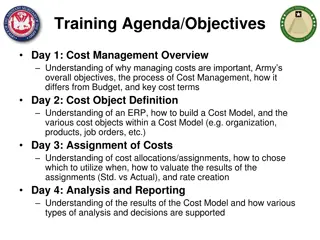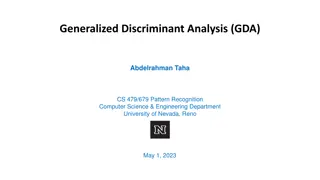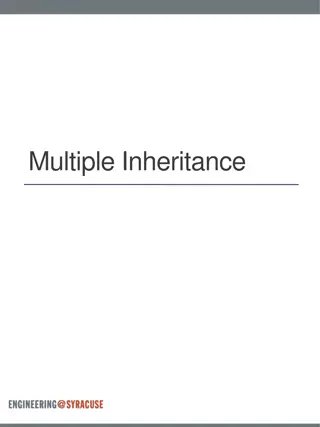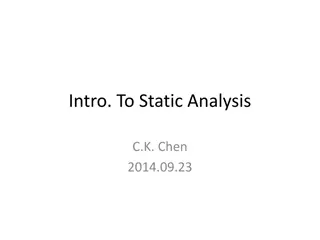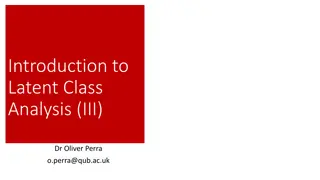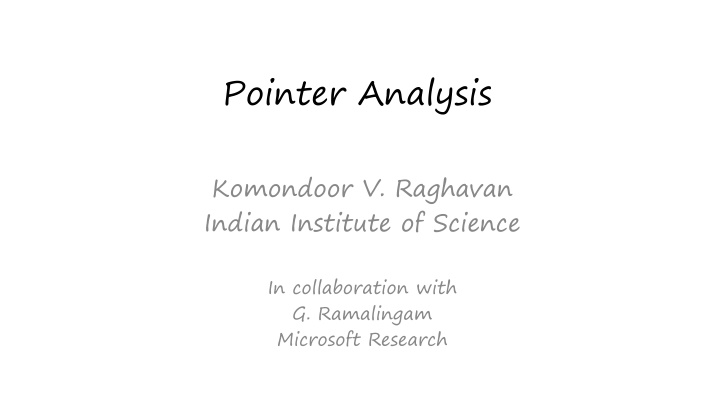
Advanced Techniques in Pointer Analysis and Constant Propagation
Explore the concepts of pointer analysis, points-to analysis, and constant propagation in programming languages. Understand how these techniques determine possible values, targets of pointer variables, and propagate constant values in programs. Dive into the complexities of dynamic memory allocation, pointer arithmetic, and control-flow graphs.
Download Presentation

Please find below an Image/Link to download the presentation.
The content on the website is provided AS IS for your information and personal use only. It may not be sold, licensed, or shared on other websites without obtaining consent from the author. If you encounter any issues during the download, it is possible that the publisher has removed the file from their server.
You are allowed to download the files provided on this website for personal or commercial use, subject to the condition that they are used lawfully. All files are the property of their respective owners.
The content on the website is provided AS IS for your information and personal use only. It may not be sold, licensed, or shared on other websites without obtaining consent from the author.
E N D
Presentation Transcript
Pointer Analysis Komondoor V. Raghavan Indian Institute of Science In collaboration with G. Ramalingam Microsoft Research
Goals Pointer analysis or Points-to Analysis: Determine the set of possible values (addresses) that reside in pointer variables at each point in a program Compute conservative over-approximation of these sets A fundamental analysis, required by most other static analyses
A Constant Propagation Example x = 3; x is always 3 here can replace x by 3 and replace x+5 by 8 and so on y = 4; z = x + 5;
A Constant Propagation Example With Pointers x = 3; Is x always 3 here? *p = 4; z = x + 5;
A Constant Propagation Example With Pointers if (?) p = &x; else p = &y; x = 3; *p = 4; z = x + 5; most program analyses p = &y; x = 3; *p = 4; z = x + 5; p = &x; x = 3; *p = 4; z = x + 5; x is always 3 pointers affect x is always 4 x may be 3 or 4 (i.e., x is unknown in Constant Propagation lattice)
A Constant Propagation Example With Pointers if (?) p = &x; else p = &y; x = 3; *p = 4; z = x + 5; p = &y; x = 3; *p = 4; z = x + 5; p = &x; x = 3; *p = 4; z = x + 5; p always points-to y p always points-to x p may point-to x or y
Points-to Analysis Determine the set of targets a pointer variable could point-to (at each point in the program) p points-to x p stores the value &x *p denotes the location x targets could be variables or locations in the heap (dynamic memory allocation) p = &x; p = new Foo(); or p = malloc ( );
Programming Language: Syntax A program consists of a set of variables Var a control-flow graph (CFG) with every node labelled by a primitive statement A primitive statement is of the form x = null x = y x = *y x = &y; *x = y conditions skip (where x and y are variables in Var) Omitted (for now) Dynamic memory allocation Pointer arithmetic Structures and fields Procedures
Programming Language: Concrete Semantics State ::= Var -> Var , where Var = (Var U {null}) Initial state x:N, y:N, a:N, b:N x = & a x:a, y:N, a:N, b:N y = x x:a, y:a, a:N, b:N *y = &b x: a, y:a, a:b, b:N
Programming Language: Operational Semantics Meaning of primitive statements nstatestmt : State -> 2State nstate x = null (s) nstate x = &y (s) nstate x = y (s) = = = { s[x null] } { s[x y] } { s[x s(y)] }
Programming Language: Operational Semantics Meaning of primitive statements nstatestmt : State -> 2State nstate x = null (s) nstate x = &y (s) nstate x = y (s) nstate x = *y (s) = = = = { s[x null] } { s[x y] } { s[x s(y)] } { s[x s(s(y))] }, if s(y) is not null {}, otherwise
Programming Language: Operational Semantics Meaning of primitive statements nstatestmt : State -> 2State nstate x = null (s) nstate x = &y (s) nstate x = y (s) nstate x = *y (s) = = = = { s[x null] } { s[x y] } { s[x s(y)] } { s[x s(s(y))] }, if s(y) is not null { s[s(x) s(y)] }, if s(x) is not null {}, otherwise {}, otherwise nstate *x = y (s) =
Programming Language: Operational Semantics nstate x==y, T (s) nstate x==y, F (s) = { s }, if s(x) = s(y) { }, otherwise = { }, if s(x) = s(y) { s }, otherwise nstate (ss 2State)= ? ??nstate(s)
Collecting semantics Let u denote any program point Define SS(u) = { s | s is a State that can arise at point u in some execution } It is the collecting semantics at u
Ideal May Points-To information For any program point u in a program, define IdealMayPT (u) to be the function that maps each variable v to the following set: if (?) p = &x; else p = &y; q = &w; x = 3; *p = 4; z = x + 5; p:&x, q:&w SS(u) = p:&y, q:&w {w | s(v) = w, in some state s SS(u) } u IdealMayPT(u) = {p -> {x,y}, q -> {w}}
Problem statement Devise an algorithm that computes a map MayPT: V -> 2Var for any given program, such that for every point u of the program, MayPT(u) IdealMayPT(u)
May-Point-To Algorithms Compute MayPT: V -> 2Vars such that MayPT(u) IdealMayPT(u) An algorithm is said to be correct if the solution MayPT it computes satisfies u V. MayPT(u) IdealMayPT(u) An algorithm is said to be precise if the solution MayPT it computes satisfies u V. MayPT(u)=IdealMayPT(u) An algorithm 1 is said to be more precise than an algorithm 2 if for any program, MayPT1 computed by 1 and MayPT2 computed by 2 are such that for any point u in the program: u V. MayPT1(u) MayPT2(u)
Illustration if (?) p = &x; else p = &y; q = &w; x = 3; *p = 4; z = x + 5; IdealMayPT(u) = {p -> {x,y}, q -> {w}} p:&x, q:&w SS(u) = MayPT1(u) = {p -> {x,y,w}, q -> {w}} p:&y, q:&w MayPT2(u) = {p -> {x,y}, q -> {w,x}} u MayPT3(u) = {p -> {x,y,w}, q -> {w,x}} MayPT1(u) MayPT3(u), MayPT2(u) MayPT3(u), MayPT4(u) = {p -> {x}, q -> {w}}
Dataflow analysis to compute points-to information Join semi-lattice of abstract-values AbsState ::= (Var (2Var {})) { } f1 f2 iff for every v: f1(v) f2(v) f1 f2 = v. (f1 (v) f2 (v)) Abstract transformers for primitive statements ASstmt : AbsState AbsState
Illustration of transfer functions p = &x; q = &y; if (?) { q = p; } x = &a; y = &b; z = *q;
Illustration of transfer functions p p p p p p p p p p q q q q q q q q q q x x x x x x x x x x y y y y y y y y y y z z z z z z z z z z null null null null null null null null null null null null null null null null null null null null null null null null null null null null null null null null null null null null null null null null null null null null null p = &x; q = &y; if (?) { q = p; } x = &a; y = &b; z = *q; x x x x x x x x null null null null null null null null null null null null null null null null null null null null null null null null null null null null null null null null x x x x x x x y y y y y y y null null null null null null null null null null null null null null null null null null null null null x x x x x x y y y y y y null null null null null null null null null null null null null null null null null null x x x x x x x x x x null null null null null null null null null null null null null null null x x x x {x,y} {x,y} {x,y} {x,y} null null null null null null null null null null null null x x x {x,y} {x,y} {x,y} a a a null null null null null null x x {x,y} {x,y} a a b b null null x {x,y} a b {a,b}
Transfer functions AS x = y (s) AS x = null (s) AS x = &y (s) AS x = *y (s) if s(y) is not = {null} , otherwise where s*({v1, ,vn}) = s(v1) s(vn), = s[x s(y)] = s[x {null}] = s[x {y}] = s[x s*(s(y)-{null})],
The issue with store statements x = &a; y = &b; if (?) { p = &x; } else { p = &y; } x: a Weak update Weak update Strong update y: b p: {x,y} a: null *x = &c; *p = &c; x: a y: b p: {x,y} a: c x: {a,c} y: {b,c} p: {x,y} a: c
Transfer functions AS *x = y (s) = if s(x) = {null} s[z s(y)] if s(x)-{null} = {z} s[z1 s(z1) s(y)] if s(x)-{null} = {z1, , zk} [z2 s(z2) s(y)] (where k > 1) [zk s(zk) s(y)]
Transfer functions AS x==y, T (s) = s [x,y s(x) s(y)], if s(x) s(y) is non-empty AS x==y, F (s) if s(x) and s(y) both have > 1 elements = s[y s(y)-s(x)], , otherwise = s, = s[x s(x)-s(y)], = if s(x) is singleton and s(y)-s(x) is not empty if s(y) is singleton and s(x)-s(y) is not empty otherwise
Correctness of the analysis AbstractDomain Asemi-lattice(A, ) TransferFunctions For every statement st, ASst : A -> A Concrete (Collecting) Domain Asemi-lattice(C, ) TransferFunctions For every statement st, nstatest : C -> C C 2State A AbsState
Correctness of the analysis (S 2State) = v. {x | exists s in S such that s(v) = x } (a) = {s | for each pointer variable p, s(p) a(p)}
Correctness of the analysis Need to show that for any statement st, and for any d A: Also, need to show that form a Galois connection ASst(d) (nstate st( (d)) OR for any statement st, and for any c C: (ASst( (c)) nstate st(c)
Correctness illustration x: &y y: &x z: &a x: {&y} y: {&x,&z} z: {&a} x: &y y: &z z: &a *y = &b; nstate *y = &b; AS x: &b y: &x z: &a x: {&y,&b} y: {&x,&z} z: {&a,&b} x: &y y: &z z: &b
Correctness illustration x: &c y: &x w: &c t: &b x: &b y: &w w: &b t: &c x: {&b,&c} y: {&w,&x} w: {&b,&c} t: {&b,&c} *y = t; *y = t; AS nstate x: {&b,&c} y: {&w,&x} w: {&b,&c} t: {&b,&c} x: &b y: &x w: &c t: &b x: &b y: &w w: &c t: &c .
Transfer function is not distributive x: &c y: &x w: &c t: &b ? *y = t; ? ? = AS x: {&b,&c} y: {&w,&x} w: {&b,&c} t: {&b,&c} x: &b y: &x w: &c t: &b *y = t; ? AS x: &b y: &w w: &b t: &c ? x: {&b,&c} y: {&w,&x} w: {&b,&c} t: {&b,&c} AS *y = t; x: &b y: &w w: &c t: &c ? j ? = x: &b y: {&w,&x} w: &c t: {&b,&c}
Is The Precise Solution Computable? Claim: The set SS(u) of reachable concrete states (for our language) is precisely computable. (However, the dataflow formulation presented above is imprecise) Note: This is true for any collecting semantics with a finite state space. This is true only for the restricted language (without memory allocation)!
Precise Points-To Analysis: Caveats Theorem: Precise may-alias analysis is undecidable in the presence of dynamic memory allocation. Add x = new/malloc () to language State-space becomes infinite An aside: Integer variables + conditional- branching involving integer variables also makes any precise analysis undecidable (say, constant propagation, even without pointers) For integer variables we can use CP or interval analysis, and simultaneously use AbsState for pointer variables
Dynamic Memory Allocation s: x = new () / malloc () Introduce a pseudo-variable Vs to represent objects allocated at statement s, and use previous algorithm treat s as if it were x = &Vs also track what the fields of Vs point to allocation-site based approach
Illustration of transfer functions p = new; // v1 c = null; do { c = new; // v2 c.prev = p; p = c; }
Abstract lattice definition Var = PseudoVar {null} AbsState ::= (PseudoVar Field > (2Var {})) { } (Var -> (2Var {})) f1 f2 iff for every v, f1(v) f2 (v), and f1 f2 = v. (f1 (v) f2 (v)) (vi,f).(f1(vi,f) f2 (vi,f)) for every (vi,f), f1(vi,f) f2 (vi,f),
Transfer functions AS[ v.f = w ] s = AS[ v = w.f ] s = s [v sf*(s(w)-{null})] AS[ x==y, false branch] s = s v = w , v = new , x==y true branch have same AS as before s[v1.f s(v1.f) s(w)] [vn.f s(vn.f) s(w)] if s(v) ) {null} and s(v)-{null} = {v1, , vn} = , otherwise where sf*({v1, , vn}) = s(v1.f) s(vn.f) = , otherwise if s(w) {null}
Points-to graphs p = new; // v1 c = null; do { c = new; // v2 c.prev = p; p = c; }
Illustration of concretization function ? p = new; // v1 c = null; do { c = new; // v2 c.prev = p; p = c; }
Inter-procedural analysis Context-sensitivity can be achieved using standard techniques, such as call-strings. Pointer analysis specific context-sensitivity approaches also exist, such as object-sensitivity Indirect (virtual) function call sites need to be resolved to candidate functions using points-to analysis. And points-to analysis needs calls to be resolved! Therefore, the two have to happen hand in hand.
Andersens Analysis A flow-insensitive analysis computes a single points-to solution, which over-approximates points-to solutions at all program points ignores control-flow treats program as a set of statements equivalent to collapsing the given program to have a single program point, and then applying Algorithm A on it.
Andersens Analysis If program has statements s1, s2, , sn, then create collapsed CFG as follows: Initial fact Single program point that Kildall updates s1 s2 sn After algorithm terminates, final solution at the single program point over-approximates result computed by flow-sensitive analysis at any point
Example: Andersen s Analysis x = &a; *x = &w; Before first iteration: all variables null After first iteration of Kildall: y = x; x -> {a,b,null}, all other variables null x = &b; After 2nd iteration: x -> {a,b,null}, y,z -> {a,b,null}, a,b -> {w,t,null}, all other variables null *x = &t; After 3rd iteration: X -> {a,b,null}, y,z -> {a,b,null}, a,b -> {w,t,null}, all other variables null z = x;
Notes about Andersens Analysis Strong updates never happen in Andersen s analysis! If x->{y} and y->{w} before we process statement *x = &z , then even if transfer function returns y->{z}, due to subsequent join, y will point to {w,z} after this step. Flow-insensitive style can be adopted for any analysis, not just for pointer analysis
Why Flow-Insensitive Analysis? Reduced space requirements a single points-to solution Reduced time complexity no copying of points-to facts individual updates more efficient a cubic-time algorithm Scales to millions of lines of code most popular points-to analysis
May-Point-To Analyses Ideal-May-Point-To more efficient / less precise Algorithm A more efficient / less precise Andersen s
Andersens Analysis: Further Optimizations and Extensions Fahndrich et al., Partial online cycle elimination in inclusion constraint graphs, PLDI 1998. Rountev and Chandra, Offline variable substitution for scaling points-to analysis, 2000. Heintze and Tardieu, Ultra-fast aliasing analysis using CLA: a million lines of C code in a second, PLDI 2001. M. Hind, Pointer analysis: Haven t we solved this problem yet?, PASTE 2001. Hardekopf and Lin, The ant and the grasshopper: fast and accurate pointer analysis for millions of lines of code, PLDI 2007. Hardekopf and Lin, Exploiting pointer and location equivalence to optimize pointer analysis, SAS 2007. Hardekopf and Lin, Semi-sparse flow-sensitive pointer analysis, POPL 2009.
Context-Sensitivity Etc. Liang & Harrold, Efficient computation of parameterized pointer information for interprocedural analyses. SAS 2001. Lattner et al., Making context-sensitive points-to analysis with heap cloning practical for the real world, PLDI 2007. Zhu & Calman, Symbolic pointer analysis revisited. PLDI 2004. Whaley & Lam, Cloning-based context-sensitive pointer alias analysis using BDD, PLDI 2004. Rountev et al. Points-to analysis for Java using annotated constraints. OOPSLA 2001. Milanova et al. Parameterized object sensitivity for points-to and side-effect analyses for Java. ISSTA 2002.
Applications Compiler optimizations Any kind off Verification & Bug Finding use in preliminary phases use in verification itself









